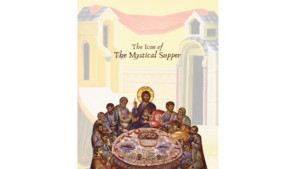The Icon of the Mystical Supper

A common icon found in our dining rooms is that of The Mystical Supper. The West calls it ‘The Last Supper’, and its iconography focuses on the tragedy of the crucifixion, and the end of Christ’s earthly ministry surrounded by deceit and betrayal. In contrast the Orthodox icon does not simply capture Christ’s last meal with his disciples, but it also focuses on the institution of the mystery of the Holy Eucharist. Through this mystery, Christ marks the beginning of a New Covenant which is to be repeated in remembrance of Him and offered up continually throughout the ages for the remission of sins and eternal life.
There are various versions of this icon which exist due to different iconographic traditions and interpretations. What is common to all such icons, however, is that that the central figure is always Christ who is fully presented, usually a little larger than His disciples. Being a liturgical event, the icon places Christ as the head of the Church and the twelve disciples surrounding Him around the table as the body.
The table is usually filled with various utensils, wine, herbs and some bread in front of each of the disciples. It looks like a proper meal, however, we see Christ blessing the bread and wine with his right hand to mystically offer them as His own body and blood (Luke 22:18-20). For this reason, the table is depicted as round, having no end, to symbolise the eternal heavenly communion in the Kingdom of God. With His left hand, Jesus is holding a scroll. This represents the establishment of the New Covenant with the Church and the fulfilment of the Old Covenant that had been given to the Israelites. This is supported by the absence of the Paschal lamb from the table which would have been the “main meal” of the Jewish Passover. Instead, Christ is present as the Paschal lamb and He seals the New Covenant with His own body and blood.
Apart from Jesus, the disciples do not have a halo given that the Holy Spirit had not yet descended upon them. St John the Theologian and Evangelist is always depicted reclining on Christ’s breast as mentioned in his Gospel (John 13:23-26). This also reflects the common tradition which states that St John received the grace of theology when he leaned his head on Christ’s heart. The other easily recognisable disciple, Judas Iscariot, is shown reaching over the table for the bowl to dip his bread in. Besides indicating his hidden greediness, this also shows how Jesus identified who would betray Him.
Finally, the background of the icon depicts some buildings which are covered with a red canopy to indicate that the event took place indoors. Symbolically it alludes to the secrecy of the Holy Mystery which we promise not to reveal to the enemies of Christ, nor to betray Him as did Judas, as is chanted in the communion hymn. Spiritually, this upper room is the raised intellect illumined by the divine light of mystical knowledge, which is usually indicated by the lit candles found on the table.
Source: Lychnos April 2022 /May 2022
